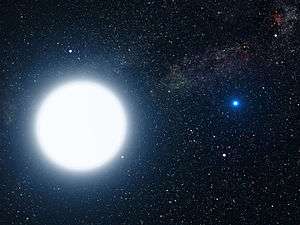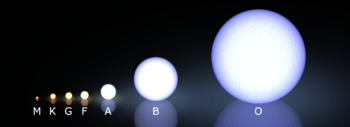A-type main-sequence star
An A-type main-sequence star (A V) or A dwarf star is a main-sequence (hydrogen-burning) star of spectral type A and luminosity class V. These stars have spectra which are defined by strong hydrogen Balmer absorption lines.[1][2] They have masses from 1.4 to 2.1 times the mass of the Sun and surface temperatures between 7600 and 10,000 K.[3] Bright and nearby examples are Altair (A7 V), Sirius A (A1 V), and Vega (A0 V).[4] A-type stars don't have a convective zone and thus aren't expected to harbor a magnetic dynamo. As a consequence, because they don't have strong stellar winds they lack a means to generate X-ray emission.[5]

In July 2019, astronomers reported finding an A-type star, S5-HVS1, traveling 1,755 km/s (3,930,000 mph), faster that any other star detected so far. The star is in the Grus (or Crane) constellation in the southern sky, and about 29,000 light-years from Earth, and may have been ejected out of the Milky Way galaxy after interacting with Sagittarius A*, the supermassive black hole at the center of the galaxy.[6][7][8][9][10]
Spectral standard stars
| Stellar Class |
Mass (M☉) |
Radius (R☉) |
Mv | Teff (K) |
|---|---|---|---|---|
| A0V | 2.40 | 1.87 | 0.7 | 9727 |
| A2V | 2.19 | 1.78 | 1.3 | 8820 |
| A5V | 1.86 | 1.69 | 2. | 7880 |
| A6V | 1.8 | 1.66 | 2.1 | 7672 |
| A7V | 1.74 | 1.63 | 2.3 | 7483 |
| A8V | 1.66 | 1.6 | 2.4 | 7305 |
| A9V | 1.62 | 1.55 | 2.5 | 7112 |
The revised Yerkes Atlas system[12] listed a dense grid of A-type dwarf spectral standard stars, but not all of these have survived to this day as standards. The "anchor points" and "dagger standards" of the MK spectral classification system among the A-type main-sequence dwarf stars, i.e. those standard stars that have remain unchanged over years and can be considered to define the system, are Vega (A0 V), Gamma Ursae Majoris (A0 V), and Fomalhaut (A3 V).[13][14] The seminal review of MK classification by Morgan & Keenan (1973)[14] didn't provide any dagger standards between types A3 V and F2 V. HD 23886 was suggested as an A5 V standard in 1978.[15] Richard Gray & Robert Garrison provided the most recent contributions to the A dwarf spectral sequence in a pair of papers in 1987[16] and 1989.[17] They list an assortment of fast- and slow-rotating A-type dwarf spectral standards, including HD 45320 (A1 V), HD 88955 (A2 V), 2 Hydri (A7 V), 21 Leonis Minoris (A7 V), and 44 Ceti (A9 V). Besides the MK standards provided in Morgan's papers and the Gray & Garrison papers, one also occasionally sees Delta Leonis (A4 V) listed as a standard. There are no published A6 V and A8 V standard stars.

Planets
A-type stars are young (typically few hundred million years old) and many emit infrared (IR) radiation beyond what would be expected from the star alone. This IR excess is attributable to dust emission from a debris disk where planets form.[18] Surveys indicate massive planets commonly form around A-type stars although these planets are difficult to detect using the Doppler spectroscopy method. This is because A-type stars typically rotate very quickly, which makes it difficult to measure the small Doppler shifts induced by orbiting planets since the spectral lines are very broad.[19] However, this type of massive star eventually evolves into a cooler red giant which rotates more slowly and thus can be measured using the radial velocity method.[19] As of early 2011 about 30 Jupiter class planets have been found around evolved K-giant stars including Pollux, Gamma Cephei and Iota Draconis. Doppler surveys around a wide variety of stars indicate about 1 in 6 stars having twice the mass of the Sun are orbited by one or more Jupiter-sized planets, compared to about 1 in 16 for Sun-like stars. [20]
A-type star systems known to feature planets include Fomalhaut, HD 15082, Beta Pictoris and HD 95086 b.
List of stars
| Name | Spectral type |
Constellation | vis Mag | Mass (M☉) |
Radius (R☉) |
Luminosity (L☉) |
Distance (ly) |
|---|---|---|---|---|---|---|---|
| Altair | A7 V | Aquila | 0.76 | 1.79 | 1.63-2.03 | 10.6 | 16.73 |
| Vega | A0 Va | Lyra | 0.026 | 2.135 | 2.362 × 2.818 | 40.12 | 25.04 |
| Sirius | A0mA1 Va | Canis Major | -1.47 | 2.063 | 1.711 | 25.4 | 8.60 ± 0.04 |
See also
- Star count, survey of stars
- B-type main-sequence star
References
- Stellar Spectral Types, entry at hyperphysics.phy-astr.gsu.edu, accessed on line June 19, 2007.
- "An Introduction to Modern Astrophysics" by B.W Caroll and D.A Ostlie 1996 edition, chapter 8
- Empirical bolometric corrections for the main-sequence, G. M. H. J. Habets and J. R. W. Heintze, Astronomy and Astrophysics Supplement 46 (November 1981), pp. 193–237, Tables VII and VIII.
- SIMBAD, entries on Sirius A and Vega, accessed June 19, 2007.
- Schröder, C.; Schmitt, J. H. M. M. (November 2007), "X-ray emission from A-type stars", Astronomy and Astrophysics, 475 (2): 677–684, Bibcode:2007A&A...475..677S, doi:10.1051/0004-6361:20077429.
- Overbye, Dennis (14 November 2019). "A Black Hole Threw a Star Out of the Milky Way Galaxy - So long, S5-HVS1, we hardly knew you". The New York Times. Retrieved 18 November 2019.
- Koposov, Sergey E.; et al. (2019). "Discovery of a nearby 1700 km/s star ejected from the Milky Way by Sgr A*". Monthly Notices of the Royal Astronomical Society. arXiv:1907.11725. doi:10.1093/mnras/stz3081.
- Starr, Michelle (31 July 2019). "Bizarre Star Found Hurtling Out of Our Galaxy Centre Is Fastest of Its Kind Ever Seen". ScienceAlert.com. Retrieved 18 November 2019.
- Irving, Michael (13 November 2019). "Fastest star ever found is being flicked out of the Milky Way". NewAtlas.com. Retrieved 18 November 2019.
- Plait, Phil (13 November 2019). "Our Local Supermassive Black Hole Shot A Star Right Out Of THe Galaxy". Bad Astronomy. Retrieved 19 November 2019.
- Adelman, S. J. (2005). "The physical properties of normal A stars". Proceedings of the International Astronomical Union. 2004: 1–11. Bibcode:2004IAUS..224....1A. doi:10.1017/S1743921304004314.
- Fundamental stellar photometry for standards of spectral type on the revised system of the Yerkes spectral atlas H.L. Johnson & W.W. Morgan, 1953, Astrophysical Journal, 117, 313
- MK ANCHOR POINTS, Robert F. Garrison
- Spectral Classification, W.W. Morgan & P.C. Keenan, 1973, Annual Review of Astronomy and Astrophysics, vol. 11, p.29
- Revised MK Spectral Atlas for stars earlier than the sun, W.W. Morgan, W. W., H.A. Abt, J.W. Tapscott, 1978, Williams Bay: Yerkes Observatory, and Tucson: Kitt Peak National Observatory
- The early A type stars – Refined MK classification, confrontation with Stroemgren photometry, and the effects of rotation, R.O. Gray & R.F. Garrison, 1987, Astrophysical Journal Supplement Series, vol. 65, p. 581
- The late A-type stars – Refined MK classification, confrontation with Stromgren photometry, and the effects of rotation, R.O. Gray & R.F. Garrison, 1989, Astrophysical Journal Supplement Series, vol. 70, p. 623
- Song, Inseok; et al. (2002), "M-Type Vega-like Stars", The Astronomical Journal, 124 (1): 514–518, arXiv:astro-ph/0204255, Bibcode:2002AJ....124..514S, doi:10.1086/341164
- Retired A Stars and Their Companions: Exoplanets Orbiting Three Intermediate-Mass Subgiants, John A. Johnson, Debra A. Fischer, Geoffrey W. Marcy, Jason T. Wright, Peter Driscoll, R. P. Butler, Saskia Hekker, Sabine Reffert, Steven S. Vogt, 19 Apr 2007
- Johnson, J. A. (2011). "The Stars that Host Planets". Sky & Telescope (April): 22–27.
| Wikimedia Commons has media related to White main sequence stars. |